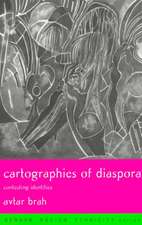Mimesis and Alterity: A Particular History of the Senses
Autor Michael Taussigen Limba Engleză Paperback – 21 dec 1992
| Toate formatele și edițiile | Preț | Express |
|---|---|---|
| Paperback (2) | 310.45 lei 43-57 zile | |
| Taylor & Francis – 29 mai 2018 | 310.45 lei 43-57 zile | |
| Taylor & Francis – 21 dec 1992 | 450.40 lei 43-57 zile | |
| Hardback (1) | 1000.27 lei 43-57 zile | |
| Taylor & Francis – 29 mai 2018 | 1000.27 lei 43-57 zile |
Preț: 450.40 lei
Nou
Puncte Express: 676
Preț estimativ în valută:
86.18€ • 90.22$ • 71.31£
86.18€ • 90.22$ • 71.31£
Carte tipărită la comandă
Livrare economică 07-21 aprilie
Preluare comenzi: 021 569.72.76
Specificații
ISBN-13: 9780415906876
ISBN-10: 0415906873
Pagini: 320
Ilustrații: 25 b&w photographs, 20 line drawings
Dimensiuni: 152 x 229 x 21 mm
Greutate: 0.48 kg
Ediția:New.
Editura: Taylor & Francis
Colecția Routledge
Locul publicării:Oxford, United Kingdom
ISBN-10: 0415906873
Pagini: 320
Ilustrații: 25 b&w photographs, 20 line drawings
Dimensiuni: 152 x 229 x 21 mm
Greutate: 0.48 kg
Ediția:New.
Editura: Taylor & Francis
Colecția Routledge
Locul publicării:Oxford, United Kingdom
Recenzii
"Taussig's deeply informed anthropological readings present us with a contemporary cabinet of curiosities that informs the longstanding fascination with the primitive in the constitution of the modern, and shocks us, in the spirit of Benjamin, into reconsidering what we thought we had largely dismissed in our concerns with the politics of representation." -- George E. Marcus, Rice University
"In Mimesis and Alterity Taussig investigates the contacts between anthropologists and subjects and the world created therein . . . his accounts have the tactility one gets from a good storyteller." -- Artforum
"This book can most profitably be read in conjunction with Taussig's provocatice and often original earlier works (e.g. The Devil and Commodity Fetishism) since these provide the details of the historical and cultural stage of mimetic performance." -- Bulletin of Society for the Anthropology of Europe
"In Mimesis and Alterity Taussig investigates the contacts between anthropologists and subjects and the world created therein . . . his accounts have the tactility one gets from a good storyteller." -- Artforum
"This book can most profitably be read in conjunction with Taussig's provocatice and often original earlier works (e.g. The Devil and Commodity Fetishism) since these provide the details of the historical and cultural stage of mimetic performance." -- Bulletin of Society for the Anthropology of Europe
Cuprins
1: In Some Way or Another One Can Protect Oneself From the Spirits By Portraying Them; 2: Physiognomic Aspects of Visual Worlds; 3: Spacing Out; 4: The Golden Bough: The Magic of Mimesis; 5: The Golden Army: The Organization of Mimesis; 6: With the Wind of World History in Our Sails; 7: Spirit of the Mime, Spirit of the Gift; 8: Mimetic Worlds, Invisible Counterparts; 9: The Origin Of the World; 10: Alterity; 11: The Color of Alterity; 12: The Search for the White Indian; 13: America As Woman: The Magic of Western Gear; 14: The Talking Machine; 15: His Master’s Voice; 16: Reflection; 17: Sympathetic Magic in a Post-Colonial Age
Descriere
Descriere de la o altă ediție sau format:
This ambitious work explores the complex and interwoven concepts of mimesis, the practice of imitation, and alterity, the opposition of Self and Other. Drawing on the ideas of Benjamin, Adorno and Horckheimer and ethnographic accounts of the Cuna, Taussig demonstrates how the history of mimesis is deeply tied to colonialism and the idea of alterity has become increasingly unstable. Twenty years after the original publication, Taussig revisits the work in a new preface which contextualises the impact of Mimesis and Alterity. Vigorous and unorthodox, this cross-cultural discussion continues to deepen our understanding of the relationship between ethnography, racism and society.
This ambitious work explores the complex and interwoven concepts of mimesis, the practice of imitation, and alterity, the opposition of Self and Other. Drawing on the ideas of Benjamin, Adorno and Horckheimer and ethnographic accounts of the Cuna, Taussig demonstrates how the history of mimesis is deeply tied to colonialism and the idea of alterity has become increasingly unstable. Twenty years after the original publication, Taussig revisits the work in a new preface which contextualises the impact of Mimesis and Alterity. Vigorous and unorthodox, this cross-cultural discussion continues to deepen our understanding of the relationship between ethnography, racism and society.



















